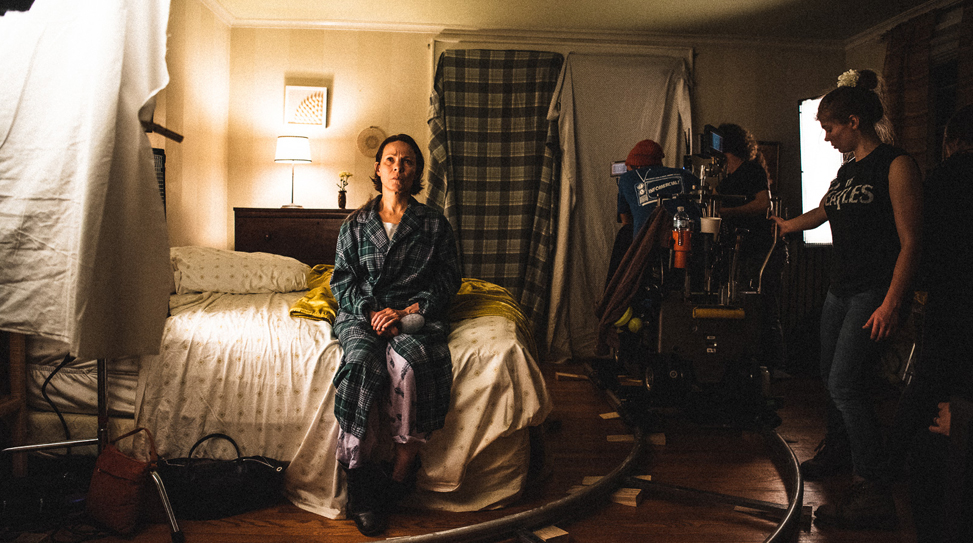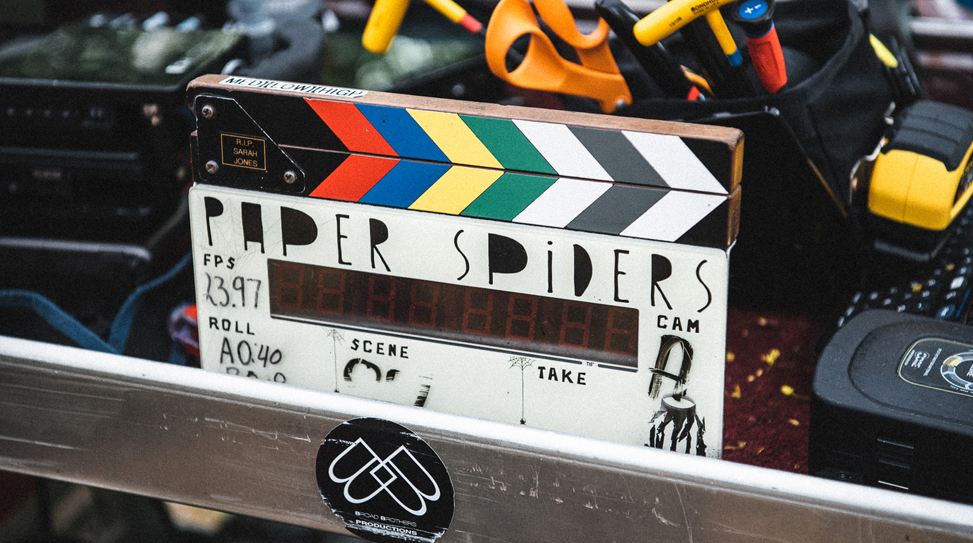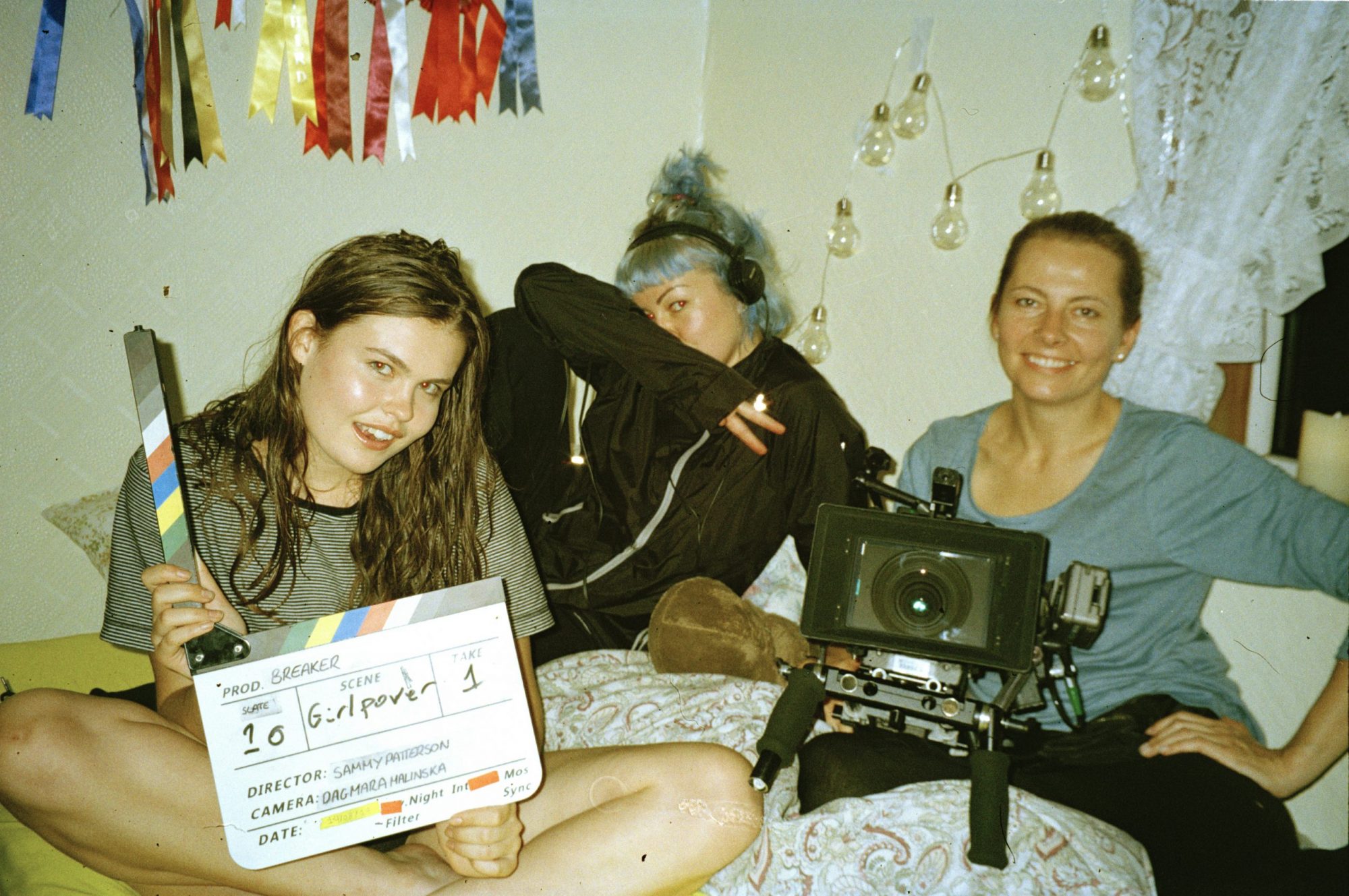Paper Spiders
By Michelle Miller, Editor in Chief

Watch Paper Spiders here. Watch a Q&A with the Directors of Paper Spiders Inon Shampanier ande Natalie Shampanier with Michelle Miller here.
In Inon Shampanier’s masterful Paper Spiders, the anguish of mental illness is in the details.
From the first aerial shot of a sea of black umbrellas, punctuated by a lone yellow umbrella under which a mother and daughter huddle together against the elements while on a college campus tour, it is clear that at the center of this film is a unique “us against the world” relationship. The thesis of the entire movie is revealed when the straight-A high school senior, Melanie—played with nuance and grit by Stefania LaVie Owen, admonishes her mother for loudly highlighting the perils of her daughter following her dream of attending her father’s alma mater, USC, on a full academic scholarship. Her mother, Dawn—embodied by the ferocious talent of Lili Taylor, simply replies, “Tell me how to act normal.” If only Melanie could salvage her mother’s sanity so simply.
The relationship between Dawn and Melanie isn’t merely tightknit, it is enmeshed to an almost cellular level. They dine across one another’s plates, like Jack Sprat and his wife, each eating what the other doesn’t want. They complete crosswords together with Melanie telling her mother to “stick to the vertical” on a loop. It appears that Melanie, a precocious and studious girl who watches surgeries out of curiosity, has become so accustomed to trying to contain Dawn’s eccentricities that it is second nature, instead of cause for alarm for her.

It’s not until a new neighbor backs their moving truck into a beloved tree that was planted by Dawn’s husband years earlier that her quirks are revealed to be cracks that are becoming chasms in her psyche. When she scrambles to the roof to see if the neighbor is perched there spying, we realize her mental health is precarious and slipping away like the roof tiles that smash to the concrete below as she screams for Melanie to inspect the perimeter of their home. This sets off a chain of events that escalates to restraining orders, the torpedoing of a romantic prospect, accusations of torment, police involvement, and eventually employing a private eye.
We learn through Melanie’s interactions with an ineffectual school counselor, hilariously played by Michael Cyril Creighton, the nexus of Dawn’s hyper-vigilance. The condition emerged after the loss of Melanie’s father to a massive heart attack at the age of fifty-six in the family pool two years prior. It seems to have been reanimated by her impending empty nest.
Melanie valiantly tries to distract Dawn from her illusions of torment by creating an online dating profile for her widowed mother. At the same time, Melanie finally relents to the persistent overtures of a rich, alcoholic, and tragically charming classmate named Daniel (Ian Nelson). Mother and daughter help one another primp and then stand in the doorway together awaiting their respective romantic prospects. That night, as they embark on their dates, they cross a threshold that shifts their dynamic for the rest of the film. The hanging thread that is Dawn’s grasp of reality unravels beyond reweaving. Melanie loses the safety net of her mother and is forced to take on the role of parent, protector and provider.

The storytelling, acting and cinematography of Paper Spiders is sheer perfection. There is not an extraneous shot or prop, as each has a deeper, subtler meaning that provides an intimate map of mental illness and the grave toll it takes on all in its orbit. From the rose-colored hue in the retro diner that Melanie describes as a “happy place,” to Dan’s quip, “it isn’t happy for the people who work here,” to the starkness of the light in that same diner as Melanie, clad in the vintage uniform, wearily signs up for multiple double shifts. Her solitude and financial struggles are quietly illuminated as she writes with a pen and paper in a dark lecture hall, surrounded by the laptop lights of her peers. Each and every scene is layered with intention and remarkable detail.
The storylines of the supporting cast are fleshed out with nods to backstories that hint at their own brokenness. Ian Nelson’s aching portrayal of Daniel is of a kid who peacocks his privilege to eclipse the darkness of his loneliness and addiction. Peyton List’s Lacy is a perfectly frothy foil of boy-crazy impulse control to Melanie’s grounded discernment. Perhaps one of the most stunning reversals is that of Gary, the PI, who is hired at great cost by Dawn to provide proof of the neighbor’s menace. Max Cassella initially presents as a smarmy opportunist who soon becomes one of Melanie’s few allies as she fights to keep her mother’s disintegrating sense of reason intact. Cassella is only in a few scenes, but his humor and pathos are lovely additions.

This is a film about the relationship of a mother and daughter. The believability of the entire premise hinges on the chemistry of its lead characters, and both Taylor and Owen deliver. There is a palpable connection between the two that cannot be manufactured. Lili Taylor lives each moment of Dawn so fully that one wonders how she could extricate herself from the character at the end of the shoot. Her descent is portrayed with such authenticity and commitment that it never devolves into histrionic outbursts. Instead, it burns and explodes, but all in believable measure. Stefania LaVie Owen owns the film with a staggeringly mature performance. She musters wit and Herculean strength with dignity, no matter the mounting burdens, personal horrors, embarrassments, and heartaches. We cringe and cry for the young woman robbed of joyful milestones but in Owens beautifully textured portrayal, she elicits more than our pity; she earns our respect.
Inon Shampanier’s gentle direction of this story is indicative of his own experience observing a loved one with this harrowing illness. His wife, and co-writer, Natalie Shampanier experienced it first hand with her own mother. Initially, the duo didn’t want to share their inspiration for the film. It was too raw, too personal. Over the course of the project, however, they realized how many families are touched by the challenges of delusional disorder and other similar illnesses. Ultimately, sharing their own story became an opportunity to foster a community engaged in healing through sharing without shame.
Watch Paper Spiders here. Watch a Q&A with the Directors of Paper Spiders Inon Shampanier ande Natalie Shampanier with Michelle Miller here.

